
A computer monitor is an output device that displays information in pictorial or textual form. A discrete monitor comprises a visual display, support electronics, power supply, housing, electrical connectors, and external user controls.

A liquid-crystal display (LCD) is a flat-panel display or other electronically modulated optical device that uses the light-modulating properties of liquid crystals combined with polarizers. Liquid crystals do not emit light directly but instead use a backlight or reflector to produce images in color or monochrome. LCDs are available to display arbitrary images or fixed images with low information content, which can be displayed or hidden: preset words, digits, and seven-segment displays are all examples of devices with these displays. They use the same basic technology, except that arbitrary images are made from a matrix of small pixels, while other displays have larger elements. LCDs can either be normally on (positive) or off (negative), depending on the polarizer arrangement. For example, a character positive LCD with a backlight will have black lettering on a background that is the color of the backlight, and a character negative LCD will have a black background with the letters being of the same color as the backlight. Optical filters are added to white on blue LCDs to give them their characteristic appearance.

Toshiba Corporation is a Japanese multinational electronics company headquartered in Minato, Tokyo, Japan. Its diversified products and services include power, industrial and social infrastructure systems, elevators and escalators, electronic components, semiconductors, hard disk drives (HDD), printers, batteries, lighting, as well as IT solutions such as quantum cryptography which has been in development at Cambridge Research Laboratory, Toshiba Europe, located in the United Kingdom, now being commercialised. It was one of the biggest manufacturers of personal computers, consumer electronics, home appliances, and medical equipment. As a semiconductor company and the inventor of flash memory, Toshiba had been one of the top 10 in the chip industry until its flash memory unit was spun off as Toshiba Memory, later Kioxia, in the late 2010s.
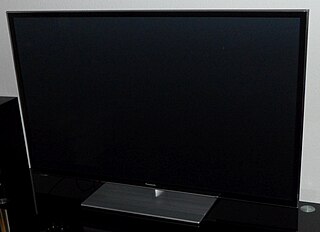
A plasma display panel (PDP) is a type of flat panel display that uses small cells containing plasma: ionized gas that responds to electric fields. Plasma televisions were the first large flat panel displays to be released to the public.
A thin-film transistor (TFT) is a special type of field-effect transistor (FET) where the transistor is made by thin film deposition. TFTs are grown on a supporting substrate. A common substrate is glass, because the traditional application of TFTs is in liquid-crystal displays (LCDs). This differs from the conventional bulk metal oxide field effect transistor (MOSFET), where the semiconductor material typically is the substrate, such as a silicon wafer.
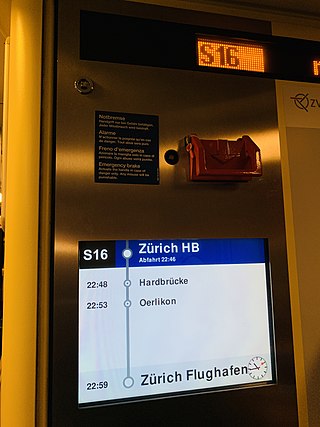
A flat-panel display (FPD) is an electronic display used to display visual content such as text or images. It is present in consumer, medical, transportation, and industrial equipment.

The IBM ThinkPad 701 is a subnotebook in the ThinkPad line by IBM. The 701 is colloquially known as the Butterfly due to its sliding keyboard, which was designed by John Karidis. It was developed from 1993 and sold from March 1995 until later that year and priced between $1,499 and $3,299. The 701 was the most sold laptop in 1995 and has received 27 design awards. It was based on either the DX2 or the DX4 version of the Intel i486, combined with CT-65545 graphics chip from Chips and Technologies. The 701Cs version used a DSTN display, while the 701C used a TFT LCD. It was pre-installed with Windows 3.11 and for the DX4 models also with OS/2 Warp 3.0. The 701 was discontinued because the keyboard design was no longer a necessity after screen sizes increased. After its discontinuation there has been some speculation about a new notebook with a butterfly style keyboard.

A field-emission display (FED) is a flat panel display technology that uses large-area field electron emission sources to provide electrons that strike colored phosphor to produce a color image. In a general sense, an FED consists of a matrix of cathode ray tubes, each tube producing a single sub-pixel, grouped in threes to form red-green-blue (RGB) pixels. FEDs combine the advantages of CRTs, namely their high contrast levels and very fast response times, with the packaging advantages of LCD and other flat-panel technologies. They also offer the possibility of requiring less power, about half that of an LCD system. FEDs can also be made transparent.

A surface-conduction electron-emitter display (SED) was a display technology for flat panel displays developed by a number of companies. SEDs used nanoscopic-scale electron emitters to energize colored phosphors and produce an image. In a general sense, a SED consists of a matrix of tiny cathode-ray tubes, each "tube" forming a single sub-pixel on the screen, grouped in threes to form red-green-blue (RGB) pixels. SEDs combine the advantages of CRTs, namely their high contrast ratios, wide viewing angles, and very fast response times, with the packaging advantages of LCD and other flat panel displays.

AUO Corporation is a Taiwanese company that specialises in optoelectronic solutions. It was formed in September 2001 by the merger of Acer Display Technology, Inc. and Unipac Optoelectronics Corporation. AUO offers display panel products and solutions, and in recent years expanded its business to smart retail, smart transportation, general health, solar energy, circular economy and smart manufacturing service.
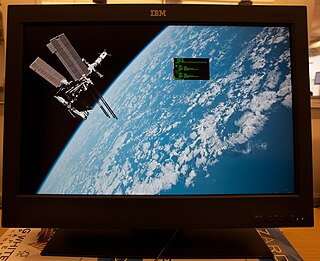
The IBM T220 and T221 are LCD monitors that were sold between 2001 and 2005, with a native resolution of 3840×2400 pixels (WQUXGA) on a screen with a diagonal of 22.2 inches (564 mm). This works out to 9,216,000 pixels, with a pixel density of 204 pixels per inch, much higher than contemporary computer monitors and approaching the resolution of print media. The display family was nicknamed "Big Bertha" in some trade journals. Costing around $8,400 in 2003, the displays saw few buyers. Such high-resolution displays would remain niche products for nearly a decade until modern high-dpi displays such as Apple's Retina display line saw more-widespread adoption.
Orbotech Ltd. a subsidiary of KLA Corporation and a technology company used in the manufacturing of consumer and industrial products throughout the electronics and adjacent industries. The company providing electronics reading, writing, and connecting solutions used by manufacturers of printed circuit boards, flat panel displays, advanced packaging, micro-electro-mechanical systems and other electronic components. The company is headquartered in Yavne, Israel and operates in North America, Europe, Japan and Asia-Pacific.

Sharp Corporation is a Japanese electronics company. It is headquartered in Sakai, Osaka and was founded by Tokuji Hayakawa in 1912 in Honjo, Tokyo and established as the Hayakawa Metal Works Institute in Abeno, Osaka in 1924. Since 2016, it is majority owned by Taiwan-based manufacturer Hon Hai Precision Industry Co., Ltd., better known as Foxconn.
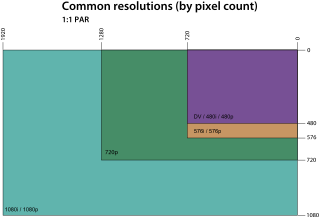
The graphics display resolution is the width and height dimension of an electronic visual display device, measured in pixels. This information is used for electronic devices such as a computer monitor. Certain combinations of width and height are standardized and typically given a name and an initialism which is descriptive of its dimensions. A graphics display resolution can be used in tandem with the size of the graphics display to calculate pixel density. An increase in the pixel density often correlates with a decrease in the size of individual pixels on a display.

Japan Display Inc., commonly called by its abbreviated name, JDI, is the Japanese display technology joint venture formed by the merger of the small and medium-sized liquid crystal display businesses of Sony, Toshiba, and Hitachi.

BOE Technology Group Co., Ltd., or Jingdongfang, is a Chinese electronic components producer founded in April 1993. Its core businesses are interface devices, smart IoT systems and smart medicine and engineering integration. BOE is one of the world's largest manufacturers of LCD, OLEDs and flexible displays.
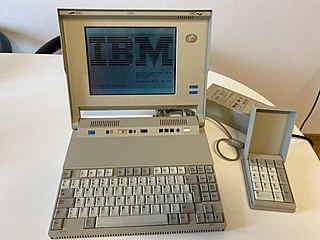
The IBM Personal System/2 Model L40 SX is a portable computer made by IBM as part of the IBM PS/2 series. It was the successor to the IBM PC Convertible. The "SX" in the name refers to its CPU, the Intel 80386SX.
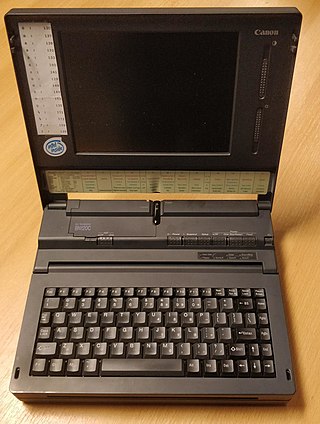
The Canon NoteJet is a series of notebook computers which include a printer and scanner that was manufactured from 1993 to 1995 by a joint venture between the Canon subsidiary Canon Computer Systems Inc. and IBM subsidiary IBM Japan. The Canon branded series was sold worldwide except in Japan, where the similar IBM ThinkPad 555BJ and 550BJ was sold. The European model did not use the NoteJet branding and was branded as the Canon BN120C, BN22 or BN200.
















